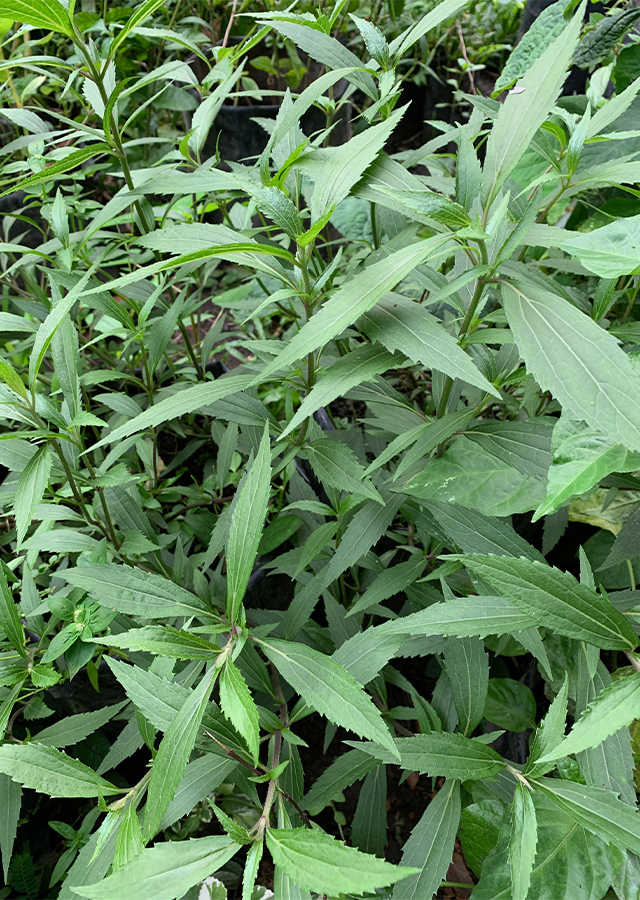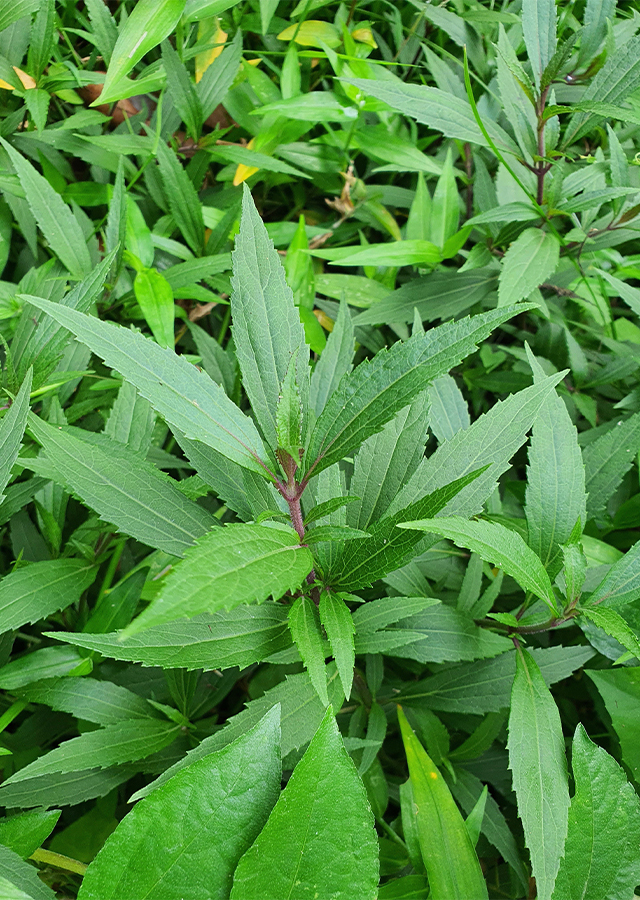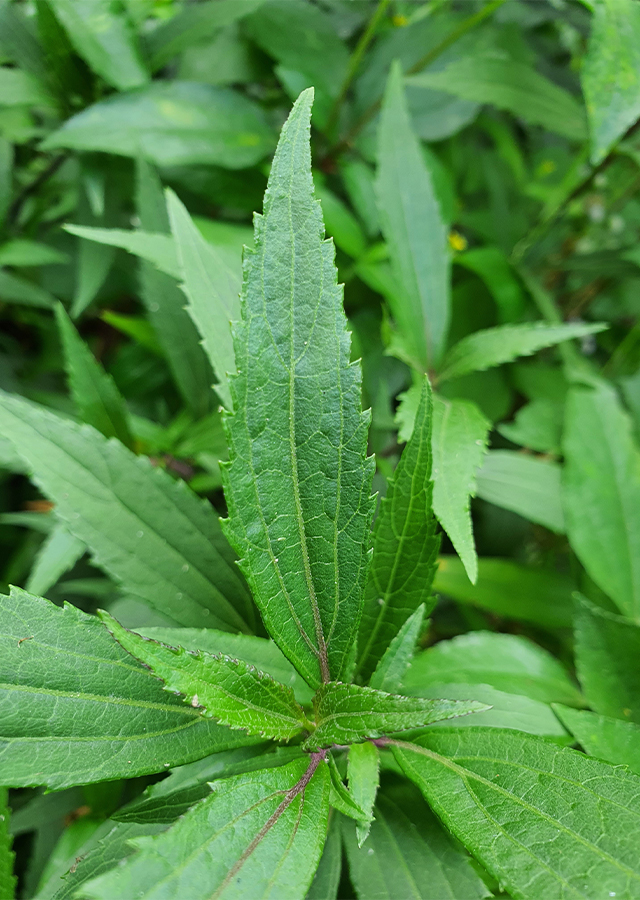Jack In The Bush
Ageratina riparia (Regel) R.M.King & H.Rob.
Asteraceae
Location in our garden
Principal



Synonym
Ageratina repens (B.L.Rob.) R.M.King & H.Rob.
Ageratina ventillana (Cuatrec.) R.M.King & H.Rob.
Eupatorium harrisii Urb.
Habitus
Herbaceous. A herb of 40-60 cm height, sometimes exceeding 1 m, with numerous spreading or ascending stems
Part Used
Leaves
Growing Requirements
Full Sunshine
Drought Resistant
Habitat
Forest
Grassland
Overview
Jack in the bush or Ageratina riparia is native to Mexico Central, Mexico Gulf, and Mexico Southwest. This species is introduced as ornamental plants and widely distributed. The plant has been used as traditional medicine for diabetes and laxative.
Vernacular Names
Lapana malgache (French), teklan (Sundanese), hāmākua pāmakani (Hawaiian).
Agroecology
Ageratina riparia naturally grows in highland meadows with high rainfall. It can invade a variety of natural forest habitats, most commonly found along riverbanks, also in disturbed areas such as roadsides, plantations, and pastures.
Morphology
- Stems - hairy and becomes glabrous near the end, produces creeping stems that root at the nodes, forming a dense mat of interwoven stems, purplish.
- Leaves - simple, opposite, petiole 1 to 13 mm long, margins sharply serrate, elliptical- to anceolate, w.acuminate end, measures 3,5-10 cm long and 1 to 1,5 cm wide.
- Flowers - numerous small white flower-heads clustered together at the tips of the branches, contains around twenty tubular flowers, 3 to 3,5 mm long, arranged in loose corymbs. The lateral branches are underpinned by 2 leafy bracts. The capitulum grouped in small corymbs. The flower's heads are bell-shaped, measure 2 mm in diameter.
- Fruits - prismatic achene with 5 ribs, of 1,5 to 2 mm long, dark brown to black, hairy.
Cultivation
Propagated by seeds - the plant is a prolific seeder and grows very fast. Germination is reduced if the seed is covered by more than a very thin sprinkling of soil. The seeds are very light and easily dispersed, 75% of fresh seeds may germinate within a week. The seeds can be dispersed by wind, running water, contamination of agricultural produce, and sticking to clothing, animals, vehicles and machinery.
Chemical Constituents
Sesquiterpene lactone, methylripariochromene A (6-acetyl-7,8-dimethoxy-2,2- dimethylchromene), diterpene lactone, flavonoids, terpenoids, sterols, saponins, tannins, quinones, steroids.
Traditional Medicinal Uses
- Studies have suggested antimicrobial, wound healing, hemostatic, antioxidant, anti inflammatory, platelet protective, anticancer, anti-anemic properties.
- In Indonesia, young leaves are used to treat wounds.
- In many tropical countries, it is used to stop bleeding and wound healing.
- In Vietnam, aqueous extract of leaves is used for the treatment of soft tissue wounds, burns wounds and skin infections.
- In Nigeria, it is used for wound healings and as anthelmintic, also used for treatment of piles.
- In the Philippines, crushed leaves are used for "kulebra", bolis and tumorous inflammtory conditions.
- In Java and Sri Lanka, it is used for its strong antifungal properties.
- in Northeast India, it is used as traditional medicine by boiling the whole plant and drinking the juice, indigenous people believe it can prevent disease caused by germs.
Part Used
Reference Sources
- Ratnayake, R, B. Bandara, N. Adikaram, D. Wijesundara, and V. Karunaratne. (2018). Potential of the antifungal activity of Ageratina riparia (Regel) R. M. King and H. Rob. against banana anthracnose disease caused by the fungus, Colletotrichum musae. Ceylon Journal of Science 47(3): 287-291 DOI: http://doi.org/10.4038/cjs.v47i3.7536
- Fern, Ken. Tropical Plants Database. Ageratina riparia. tropical.theferns.info/viewtropical.php?id=Ageratina+riparia. 30-11-2021.
- Pacific Island Ecosystems at Risk (PIER). Ageratina riparia. http://www.hear.org/pier/species/ageratina_riparia.htm. 01-12-2021.
- Porteners, M. Ageratina riparia (Regel) R.M.King & H.Rob. https://plantnet.rbgsyd.nsw.gov.au/cgi-bin/NSWfl.pl?page=nswfl&lvl=sp&name=Ageratina~riparia (accessed 01-12-2021).
- Hynniewta, S.R., & Y. Kumar. (2010). The lesser known medicine Ka Dawai Ñiangsohpet of the Khasis in Meghalaya, Northeast India. Indian Journal of Traditional Knowledge 9(3): 475-479.
